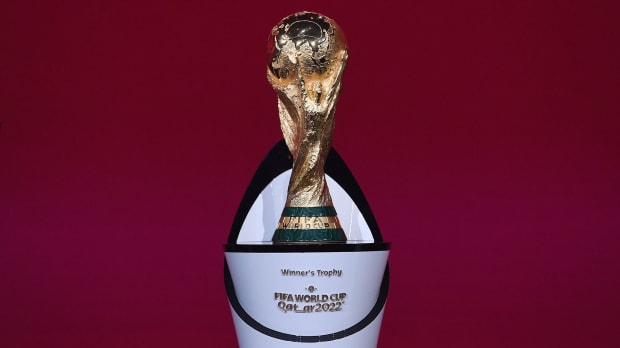Qualifying for the 2022 World Cup in Qatar is reaching its conclusion, as countries compete to fill the remaining spots in this year’s showcase on the sport’s greatest stage.
The competition, which will be held from Nov. 21-Dec. 18, 2022, will be the last 32-team edition before the 2026 World Cup across North America expands to 48 teams. Qatar secured its berth way back in December 2010, when it was awarded the right to host the competition after a bid process that has since been shrouded in controversy. In terms of allocation of the other berths, 13 spots go to Europe, five go to Africa, four and a half go to both Asia and South America, three and a half go to North and Central America and the Caribbean, and half to the Oceania region. Those “half” spots earned by teams send them to a pair of intercontinental playoffs for the last two places in the field. It was determined on Nov. 26 which regions will be paired for the playoffs, whose format has changed.
Another wrinkle to qualifying is the expulsion of Russia due to its nation’s invasion of Ukraine. The 2018 World Cup hosts were due to take part in UEFA’s playoff round for Europe’s three final berths, but a FIFA and UEFA ban removes them from contention. Ukraine is also part of the playoff process but had its request for a postponement of its playoff granted and won’t play until June.
Nevertheless, the draw for the 2022 World Cup will occur on April 1, with the March 31 FIFA ranking being used to determine the pots. Three places in Pot 4 will remain reserved for the intercontinental playoff winners and one UEFA playoff winner.
Here’s who has qualified for the 2022 World Cup and where qualifying stands for those still vying for the remaining berths.
Qualified Teams
- Qatar (host nation)
- Germany (UEFA Group J Winner) on Oct. 11, 2021
-
Denmark (UEFA Group F Winner) on Oct. 12, 2021
- Brazil (One of CONMEBOL’s top four teams) on Nov. 11, 2021
- Belgium (UEFA Group E Winner) on Nov. 13, 2021
- France (UEFA Group D Winner) on Nov. 13, 2021
- Serbia (UEFA Group A Winner) on Nov. 14, 2021
- Spain (UEFA Group B Winner) on Nov. 14, 2021
- Croatia (UEFA Group H Winner) on Nov. 14, 2021
- Switzerland (UEFA Group C Winner) on Nov. 15, 2021
- England (UEFA Group I Winner) on Nov. 15, 2021
- Netherlands (UEFA Group G Winner) on Nov. 16, 2021
- Argentina (One of CONMEBOL’s top four teams) on Nov. 16, 2021
- Iran (Top-two finisher in AFC Group A) on Jan. 27, 2022
- South Korea (Top-two finisher in AFC Group A) on Feb. 1, 2022
- Japan (Top-two finisher in AFC Group B) on March 24, 2022
- Saudi Arabia (Top-two finisher in AFC Group B) on March 24, 2022

Ulmer/Imago Images
Africa (CAF)
After the lowest-ranked 28 teams played two-legged ties, the remaining 40 teams were split into 10 groups of four that competed to advance to the final qualifying round. The winners of each group earned a spot in the last round, in which they will play two-legged ties for five total spots in the last week of March 2022.
The matchups for the final round are: Egypt vs. Senegal, Cameroon vs. Algeria, Ghana vs. Nigeria, DR Congo vs. Morocco and Mali vs. Tunisia. The first legs will take place on March 25, followed by the return legs on March 29. The Egypt-Senegal showdown is a rematch of the Africa Cup of Nations final, which Senegal won on penalties in early February.
Ivory Coast and South Africa are among the dozens of African sides whose World Cup dreams ended in the group stage.
Asia (AFC)
The 12 lowest-ranked nations played for six spots in the second round of qualifying. From there, eight groups of five teams competed, with group winners and the top five runners-up reaching the final round (normally it’d have been all group winners and the top four runners-up, but because Qatar competed in the round, which doubled as Asian Cup qualifying, and had already been guaranteed a berth in the World Cup, seven of the group winners and the top five second-place finishers advanced). Those 12 final teams are playing in two groups of six, where 10 home-and-away matchups will determine the standings. The group winners and runners-up will qualify for the World Cup, while the third-place finishers will play in a playoff for the right to compete in the intercontinental playoff.
The groups as of the opening of the March window are as follows (Iran and South Korea are already qualified):
Group A:
1. South Korea: 9 games played, 23 points, +11 goal differential (13 scored, 2 conceded)
2. Iran: 9 games played, 22 points, +9 goal differential (13 scored, 4 conceded)
-----
3. UAE: 8 games played, 9 points, 0 goal differential (6 scored, 6 conceded)
-----
4. Lebanon: 9 games played, 6 points, -6 goal differential (5 scored, 11 conceded)5. Syria: 9 games played, 5 points, -7 goal differential (8 scored, 15 conceded)6. Iraq: 8 games played, 5 points, -7 goal differential (4 scored, 11 conceded)
Group B:
1. Japan: 9 games played, 21 points, +8 goal differential (11 scored, 3 conceded)
2. Saudi Arabia: 8 games played, 19 points, +5 goal differential (10 scored, 5 conceded)
-----
3. Australia: 9 games played, 15 points, +7 goal differential (15 scored, 8 conceded)
-----4. Oman: 9 games played, 11 points, -1 goal differential (9 scored, 10 conceded)
5. China: 8 games played, 5 points, -8 goal differential (8 scored, 16 conceded)
6. Vietnam: 9 games played, 3 points, -11 goal differential (7 scored, 18 conceded)
(Italics: Automatically qualify | Bold: Go to intercontinental playoff)
Europe (UEFA)
Serbia, Spain, Switzerland, France, Belgium, Denmark, Netherlands, Croatia, England and Germany clinched first-place finishes in the group stage, cementing their places in Qatar.
The second-place finishers in each group occupied 10 spots in the 12-team final qualifying playoff round, and they are joined by two teams who cemented places via the UEFA Nations League route (the two top-ranked group winners from the Nations League that didn’t already qualify for the World Cup or the playoff through their group finish are part of this final round).
The teams in the playoff round, following Russia’s expulsion, are: Portugal, Sweden, Italy, Ukraine, Wales, Scotland, Turkey, Poland, North Macedonia, Austria and Czech Republic.
The teams were drawn into three four-team brackets (Russia’s bracket was reduced to three teams), where single-elimination matches will determine the region’s final three berths. The semifinals will take place March 24, with two of the finals occurring March 29. With Ukraine’s semifinal moved until June, one of the paths’ completion will be delayed until that window.
PATH A
Scotland vs. Ukraine
Wales vs. Austria
PATH B
Poland (bye to final after being drawn vs. Russia)
Sweden vs. Czech Republic
PATH C
Italy vs. North Macedonia
Portugal vs. Turkey
North America, Central America, Caribbean (Concacaf)
Each of the Concacaf teams ranked outside the top five played in a preliminary elimination process that whittled the bottom 30 teams down to just three. Those three teams to survive the first two rounds of qualifying (Canada, El Salvador and Panama) joined the top-five ranked Concacaf squads in the Octagonal final qualifying stage, where each team plays every opposing squad home and away. The top three teams qualify for the World Cup, and the fourth enters the intercontinental playoff. The standings for the 14-match competition entering the final window are:
1. Canada: 11 games played, 25 points, +14 goal differential (19 scored, 5 conceded)
2. United States: 11 games played, 21 points, +9 goal differential (16 scored, 7 conceded)
3. Mexico: 11 games played, 21 points, +6 goal differential (14 scored, 8 conceded)
-----
4. Panama: 11 games played, 17 points, +1 goal differential (14 scored, 13 conceded)
-----
5. Costa Rica: 11 games played, 16 points, +1 goal differential (8 scored, 7 conceded)
6. El Salvador: 11 games played, 9 points, -7 goal differential (6 scored, 13 conceded)7. Jamaica: 11 games played, 7 points, -7 goal differential (9 scored, 16 conceded)8. Honduras: 11 games played, 3 points, -17 goal differential (5 scored, 22 conceded)
(Italics: Automatically qualify | Bold: Go to intercontinental playoff)
Oceania (OFC)
The region only began the process of anointing its entrant in the intercontinental playoffs this month due to “logistical challenges presented by the COVID-19 pandemic, according to an OFC statement. And even then, the complications have persisted surrounding the tournament that is being staged in Qatar.
Two nations, Vanuatu and Cook Islands, were forced to withdraw due to COVID-19 outbreaks, while Samoa and American Samoa had already previously withdrawn.
The competition features two groups, with the top two advancing to semifinals and a March 30 final deciding the winner. But with Vanuatu and Cook Islands drawn into the same group, it allowed Solomon Islands and Tahiti to coast to the semifinals. They’ll play March 24 to determine the order of their group finish, which impacts the semifinal matchups. In the other group, favored New Zealand has already clinched its place in the semifinals and faces already-eliminated New Caledonia in their group finale. Fiji and Papua New Guinea are both on three points and will play for the other semifinal place.
Oceania’s participant in the intercontinental playoffs will face the fourth-place finisher in Concacaf, also in Qatar, in June.
South America (CONMEBOL)
Brazil became the first South American team to qualify and was followed not long after by Argentina, whose 0-0 draw against Brazil, coupled with results in other matches to close the November international window, sealed a top-four finish. In the 10-team CONMEBOL region, each nation plays against each other home and away over the course of an 18-match gauntlet. The top four teams in the single table advance to the World Cup, while the fifth-place team goes to an intercontinental playoff.
Beyond Brazil and Argentina, the standings are currently:
3. Ecuador: 16 games played, 25 points, +10 goal differential (25 scored, 15 conceded)
4. Uruguay: 16 games played, 22 points, -3 goal differential (19 scored, 22 conceded)
-----
5. Peru: 16 games played, 21 points, -4 goal differential (17 scored, 21 conceded)
-----
6. Chile: 16 games played, 19 points, -1 goal differential (19 scored, 20 conceded)
7. Colombia: 16 games played, 17 points, -3 goal differential (16 scored, 19 conceded)
8. Bolivia: 16 games played, 15 points, -12 goal differential (23 scored, 35 conceded)9. Paraguay: 16 games played, 13 points, -14 goal differential (9 scored, 23 conceded)10. Venezuela: 16 games played, 10 points, -16 goal differential (14 scored, 30 conceded)
(Italics: Automatically qualify | Bold: Go to intercontinental playoff)
Intercontinental playoff
FIFA announced on Nov. 19 a significant change to its format. One team each from Asia, Concacaf, Oceania and South America will compete for two final berths at the World Cup. Instead of the previous format, in which the teams in the two pairings would play home-and-away, two-legged ties to determine the winner, they will now play a single-elimination match at a neutral venue in Qatar. Those matches are slated to be played June 13-14, 2022—more than two months after the group draw for the World Cup proper. The draw for the intercontinental playoff on Nov. 26 resulted in the Concacaf fourth-place finisher facing the Oceania winner, while the Asian third-place playoff winner will face the fifth-place team from CONMEBOL.







